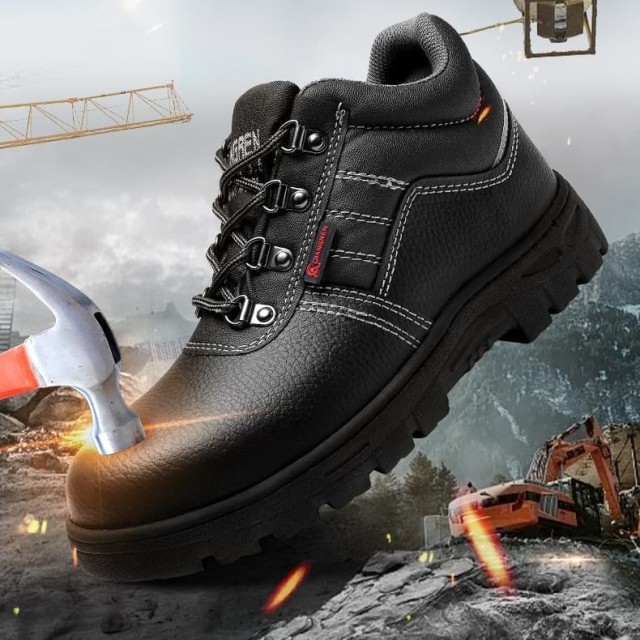When workplace hazards threaten foot safety, steel toe shoes serve as the first line of defense. These specialized shoes aren’t just about durability—they’re engineered to comply with stringent safety standards that prevent crushing injuries, punctures, and electrical hazards. But how do these standards translate to real-world protection? Let’s examine the science behind steel toe footwear and its role in keeping workers safe across industries.
Safety Standards for Steel Toe Shoes
How ASTM/OSHA Certifications Define Workplace Safety
Regulatory bodies like OSHA and ASTM International set the benchmark for protective footwear. Research shows that compliant steel toe shoes reduce workplace toe injuries by over 60% in high-risk environments. Here’s what these certifications require:
- Impact Resistance: Shoes must withstand forces ranging from 30 to 75 pound-feet (lbf)—equivalent to a heavy object falling from several feet.
- Compression Resistance: Toe caps are tested under loads of 30 to 75 rating, simulating machinery or materials crushing the foot.
- Puncture Protection: Outsoles must resist penetration from sharp objects (e.g., nails) under 270+ pounds of force.
- Electrical Safety: EH-rated shoes insulate against live circuits (up to 600V in dry conditions), while static-dissipative designs (10–100 kilo-ohms) prevent sparks in flammable settings.
These standards, outlined in ASTM F-2412 and ANSI F2413-18, ensure consistent protection across brands.
Steel vs. Composite Toes: Material Differences and Compliance
While steel toes dominate for heavy industry, composite alternatives (fiberglass, carbon fiber, or plastic) offer trade-offs:
| Feature | Steel Toe | Composite Toe |
|---|---|---|
| Protection | Highest impact resistance | Moderate impact resistance |
| Weight | Heavier | 30–50% lighter |
| Comfort | Less flexible | Better for long shifts |
| Metal Sensors | May trigger detectors | Undetectable |
Composite toes excel in electrical work or airports, while steel remains unmatched for construction and manufacturing.
Industry Applications and Injury Prevention
Case Studies: Warehouses, Construction Sites, and Manufacturing Plants
- Warehousing: A 3-year study of logistics workers showed a 52% drop in toe fractures after switching to ASTM-compliant steel toes. Crush injuries from falling pallets or heavy carts were notably reduced.
- Construction: OSHA reports link improper footwear to 17% of foot injuries in the sector. Sites enforcing steel toe policies saw a 40% decrease in incidents involving rebar or dropped tools.
- Manufacturing: Plants using EH-rated shoes eliminated 90% of electrical burns caused by accidental contact with live wires.
Statistics: Reduction in Workplace Toe Injuries
Data from the Bureau of Labor Statistics reveals:
- Over 100,000 foot injuries occur annually in the U.S., many preventable with proper footwear.
- Industries mandating certified safety shoes report 50–70% fewer claims for toe-related trauma.
Beyond Basic Protection
Additional Safety Features
Modern steel toe shoes integrate advancements like:
- Slip-Resistant Outsoles: Critical for oil-heavy environments (e.g., automotive shops), reducing fall risks by 35%.
- Waterproofing and Insulation: Keeps feet dry in cold/wet conditions, preventing frostbite or trench foot.
- Metatarsal Guards: Added shield for the mid-foot, common in foundries or heavy machinery zones.
Long-Term Durability and Cost-Efficiency
While steel toe shoes cost 20–30% more than regular work boots, their 2–3x longer lifespan offsets replacements. For employers, this means lower PPE budgets and fewer injury-related downtime costs.
Final Thoughts: Safety as an Investment
Steel toe shoes aren’t just gear—they’re a proven strategy to mitigate risks in regulated industries. Whether you prioritize OSHA compliance, electrical safety, or all-day comfort, the right choice hinges on your work environment.
Ready to equip your team with reliable protection? Partner with 3515 for bulk orders of certified safety footwear tailored to your industry’s needs. From warehouses to high-voltage sites, we deliver footwear that meets—and exceeds—safety standards.
Products You Might Be Looking For:
Explore customizable safety footwear for work
View high-performance steel toe work boots
Discover athletic-style steel toe safety shoes
Related Products
- Customizable Anti-Smash Safety Boots for Wholesale & Private Label Manufacturing
- Wholesale Mesh Steel Toe Safety Shoes with Dial Closure Factory Production
- Wholesale Anti-Smash & Puncture-Proof Safety Shoes Custom Manufacturing for Brands
- Safety Footwear Wholesale Manufacturer for Custom OEM/ODM Production
- Athletic Safety Shoes with Dial Closure & Steel Toe for Wholesale & Custom Manufacturing
Related Articles
- How to Choose Steel-Toe Boots: Matching Safety Standards to Your Job Demands
- Matching Men’s Work Shoe Safety Technologies to Workplace Hazards
- Steel-Toe vs. Composite-Toe Boots: How to Choose the Right Safety Footwear for Your Job
- How Steel Toe Shoes Prevent Injuries: The Science Behind Workplace Safety
- Steel Toe Work Boots: Balancing Safety and Comfort for Demanding Jobs



















